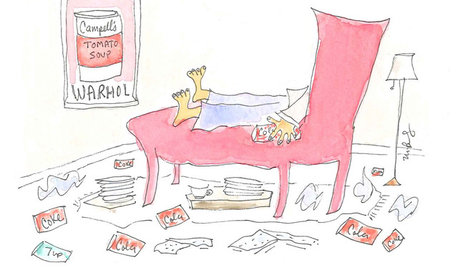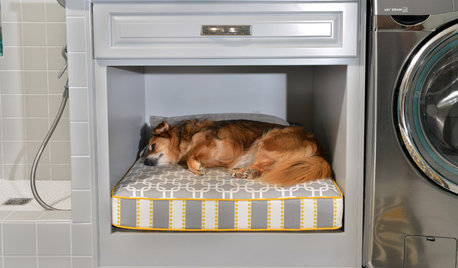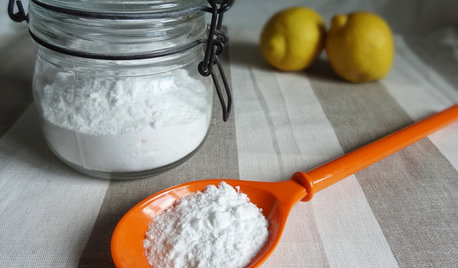My Detergent Diet
sshrivastava
12 years ago
Featured Answer
Comments (26)
Cavimum
12 years agolast modified: 9 years agoliriodendron
12 years agolast modified: 9 years agoRelated Discussions
Is it my dishwasher or my detergent?
Comments (26)there seem to be several different solutions to the same types of problems so i'll just add in my 2 cents on what happens here. our well water has a fair amount of iron in it (we test it for several things about once a year and because our water softener pooped out several months ago, we had 3 different companies here this week and they tested the water for us too). everyone is in agreement that in spite of the iron, the water remains relatively soft but warn us we should expect staining in the laundry and inside of the dishwasher. (the iron is not a health problem.) haven't found a problem in the laundry yet and yes, the inside of the dishwasher has always gotten streaky stains in it. a long time ago i bought "glisten" for that and it works great! but someone told me that citric acid works and i bought a jar of tang--much cheaper and also works great! i've never been one to "pre-wash" the dishes--just scrape off food leftovers and that seemed to be fine until we got a new dishwasher about 3 years ago. all of a sudden the dishes didn't look as good. as sheila and all the others said, hot water fixed that problem! we run the water in the sink until it's hot and then turn on the dishwasher. such a simple thing made an immediate difference for us!...See MoreTo my diet friends - sad news
Comments (14)I am doing okay today. Making progress in many paths. I have asked for God to help me for the first time in years and have many friends who are helping me as well as continuing to feel your support. I know my Mom is in a good place and that my sedative medication is history. It was not agreeing with me at all. Like a light switch I am trying hard to take the bull by the horns to take care of myself at this time. Tomorrow is a day to order flowers, clean ourselves up - I will be seeing my family doctor and will start taking responsibility for myself so I can be there in life with my family. Like all things in life, health - one step forward, one day. My problem with food now is reversed - it's hard to eat but I keep trying and drinking lots of water with our sudden heat wave. There is strength here and I feel from each of my dear friends. I will be back hopefully next week, but focusing on my health style and choices in life which I hope to learn from. I accept a higher power to guide me through this difficult time and I accept that I believe I have a substance abuse problem which I am determined to address. Let's make today count - it's precious. Lots of love to each and everyone of you. Peggy...See MoreHow to get more oil into my picky cat's diet
Comments (10)I've tried all the "high quality" brands, and most of them are made in China. I won't feed my cat anything not made in the U.S. since one of my cats died of melamine poisoning. I feed my cats Purina and Good Life when I can afford it. I don't feed her store brands. When she was young, she had bladder problems, which we figured out was because of her food. The only foods other than Good Life that don't make her bleed are indoor formulas and urinary tract formulas. There is only so much I can do on a near-poverty level income. I give her the safest and best food I can afford, sometimes doing without myself so she can have the safest food. I'd gladly feed her canned food if she would eat it, but she won't. I've wasted I don't know how much money trying to get her to eat something other than dry food, so that is a moot question. She just won't eat it. Period....See MoreWhat carbs to cut from my diet?
Comments (42)No such thing as cutting carbs too fast- there is no essential requirement for carbs, only for fats and protein. Steel cut oats are really high carb. No egg low carb breakfasts: https://draxe.com/low-carb-breakfasts/ https://www.lowcarblab.com/low-carb-breakfast-recipes/ http://healthylivinginbodyandmind.com/35-egg-free-paleo-and-low-carb-breakfast-recipes/ Also, there is no law that says you must eat "breakfast food" for breakfast. I follow the whole30 meal template and eat dinner leftovers in the morning. Based on your posts, you don't seem to have a real understanding of what low carb is. I recommend choosing a low carb plan And following it until you really understand low carb eating. The most basic would be Atkins (the early one- referred to as Atkins 72.) You should be able to pick up a used copy for just a few bucks....See MoreKappen
12 years agolast modified: 9 years agosshrivastava
12 years agolast modified: 9 years agoCavimum
12 years agolast modified: 9 years agolarsi_gw
12 years agolast modified: 9 years agosshrivastava
12 years agolast modified: 9 years agolivebetter
12 years agolast modified: 9 years agosshrivastava
12 years agolast modified: 9 years agoCavimum
12 years agolast modified: 9 years agolivebetter
12 years agolast modified: 9 years agoCavimum
12 years agolast modified: 9 years agowhirlpool_trainee
12 years agolast modified: 9 years agolivebetter
12 years agolast modified: 9 years agosshrivastava
12 years agolast modified: 9 years agowhirlpool_trainee
12 years agolast modified: 9 years agoCavimum
12 years agolast modified: 9 years agowhirlpool_trainee
12 years agolast modified: 9 years agosshrivastava
12 years agolast modified: 9 years agolivebetter
12 years agolast modified: 9 years agocolle
5 years agobeaglenc
4 years agokrazynntreal
4 years agolast modified: 4 years agoJerrod
4 years agoJerrod
4 years ago
Related Stories

HOUSEKEEPINGPortrait of a Reformed Terrible Housekeeper
See how a man who once stashed dirty dishes under the couch is turning over a new leaf for a neater home
Full Story
PETSRoom of the Day: Laundry Room Goes to the Dogs
Muddy paws are no problem in this new multipurpose room
Full Story
HOUSEKEEPINGBaking Soda: The Amazing All-Natural Cleanser You Already Own
Battle grime, banish odors and freshen clothes with this common nontoxic cupboard staple
Full Story
SAVING WATER11 Ways to Save Water at Home
Whether you live in a drought-stricken area or just want to help preserve a precious resource, here are things you can do to use less water
Full Story
BATHROOM DESIGNSpotted: Refrigerators in the Bathroom
You read that right. Before you protest, here are seven good reasons why people are chilling in the bath
Full Story
PETSSo You're Thinking About Getting a Dog
Prepare yourself for the realities of training, cost and the impact that lovable pooch might have on your house
Full Story
MOST POPULAREasy Green: 23 Ways to Reduce Waste at Home
Pick from this plethora of earth-friendly ideas to send less to the landfill and keep more money in your pocket
Full Story
LIFEHow to Outsmart Backyard Critters
Learn to think like a raccoon, skunk or squirrel to keep your home safe and your garden intact
Full Story
HOUSEKEEPINGHow to Fix a Stinky Garbage Disposal
No plumber’s fee or even a trip to the hardware store is required with these easy solutions
Full Story
MOST POPULAROvernight Guests Coming? How to Be a Great Host
Ensure a good time for all — including yourself — by following these steps for preparing for and hosting houseguests
Full Story





Pat Z5or6 SEMich